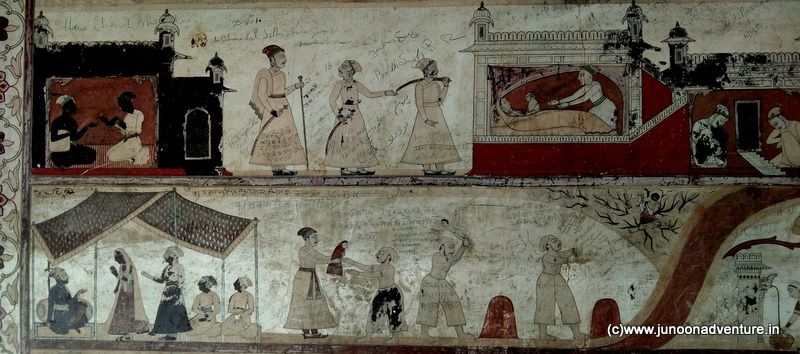“Heading out into the mountains in search of the unknown” – probably the most clichéd statement of the decade, especially now since the Indian Social Media has taken a special liking to the phenomenon of mountain wanderlust. But for us Junoonis, such trips are an annual feature. We just HAVE to head out into the mountains in search of the unknown – to keep the promise of finding a new, beautiful and relatively lesser known place for our yearly summer Himalayan trek in Himachal. And these recce trips are nothing short of a blessing!
So here we were, descending down a narrow village path as we searched for a possible location for our JT2 Parapar Got Base Camp, when something interesting and wildly beautiful caught our eye. Here was a temple, ornately carved and beautifully designed, nestled quaintly against the backdrop of a towering snow covered mountain. Now, we have seen our fair share of Himalayan wood carved temples on our travels. From the Takshak Naag Temple of Jagatsukh (near Manali) to the Bhima Kali Temple of Bushahr – the woodcraft of the Himalayan people has always left us in awe. But the rustic feel of this unkempt wooden structure was peculiar – worlds apart from the usually well-maintained, and often polished, temple structures we had seen till now. This was a temple that was just as beautifully carved and designed but missing the usual bling of popularity. It piqued our interest and we just HAD to explore.
And when we entered, we just couldn’t believe our eyes!
Beautiful, intricate and amazingly detailed – these paintings lined every inch of the outer wall of the temple’s sanctum. Walking through the ‘parikrama’ corridor of this obscure little structure was like looking at a film reel. The murals depicted Goddess Chamunda’s triumphs. Episodes from the ‘Devi Mahatmyam’ could be seen unfolding, right in front of our eyes, and that too with such vividly detailed art that we were simply awestruck!
So after several hours of clicking photos and admiring the art, the excitement started to wear off a little. And that is when curiosity started creeping in. This isn’t a style of painting that you can expect in such a remote part of the Himalayas. This is art that you wouldn’t be surprised to find displayed in the Salar Jung Museum in Delhi, in an exhibit about art from Emperor Akhbar’s era. Surely, these paintings do not belong here, 600kms away from the Mughal Capital, nestled quietly away in the obscure Himalayan village temple. What were these? How did they get here? And how come these were nothing like the Pahari art that we were accustomed to finding in these parts.
Here we were, scratching our heads, completely unaware that we were looking at an exemplary example of the Chamba School of Pahari Miniature Painting.
The Chamba Miniature Painting style is a sub-school of the larger Pahari Painting genre that came to the mountains around the time when the mighty Mughal Empire began witnessing its last few years in power. Emperor Aurangzeb wasn’t as benevolent towards the arts as his predecessors were and thus, without their patronage, artists skilled in creating the signature Mughal style of miniature paintings began moving northwards in search for better supporters. The Royals of Chamba, Nurpur, Basohli, Garhwal and even Jammu stepped up, and hence, the Pahari School of miniature paintings was born. Some amazing examples of this style of miniature paintings can be seen on display in the Bhuri Singh Museum in Chamba.
One look is enough to connect these paintings to their source – the style is so distinct and remarkable. Detailed compositions, refined and clear lines and a peculiar depiction of human faces. Miniature paintings depict simplified landscape motifs, usually as part of a scene from an emperor’s court. But as the artists moved away from Mughal patronage, the scenes changed to stories from religious texts like the Vishnu Puran and the Ramayan. The landscapes being depicted changed as well. But the rendering of the composition, style of painting, techniques and of course, depiction of human figures remained true to their original source.
Our research into the history of the valley led us back to the era of Raja Umed Singh, who ruled over Chamba between the years 1764-94. Under his patronage, the Gujarati Manikanth Gharana of artists migrated from the Mughal courts in Lahore to Chamba. They flourished in the valley and developed this signature art style into what we know as the Chamba School of Miniature Painting. The most famous artists of the era was Laharu, whose name is legendary in the genre. And while we couldn’t establish any direct connection between Laharu’s work and this obscure little temple’s murals, the style of painting definitely followed in the legend’s footsteps.
Who could have thought that the influences of a crumbling empire hundreds of kilometres away could extend its reach over mountain ranges and valleys to extend its reach so far – all the way over to this tiny little village near the borders of Pangi Valley. What a revelation!
That’s why we just LOVE our little recce trips. The search for a new destination for our annual Himalayan Trek in May uncovers a hidden and unknown gem, EVERY TIME! We seriously CANNOT wait to show this beauty off in our May 2020 Himalayan Trek – JT2 Parapar Got.



